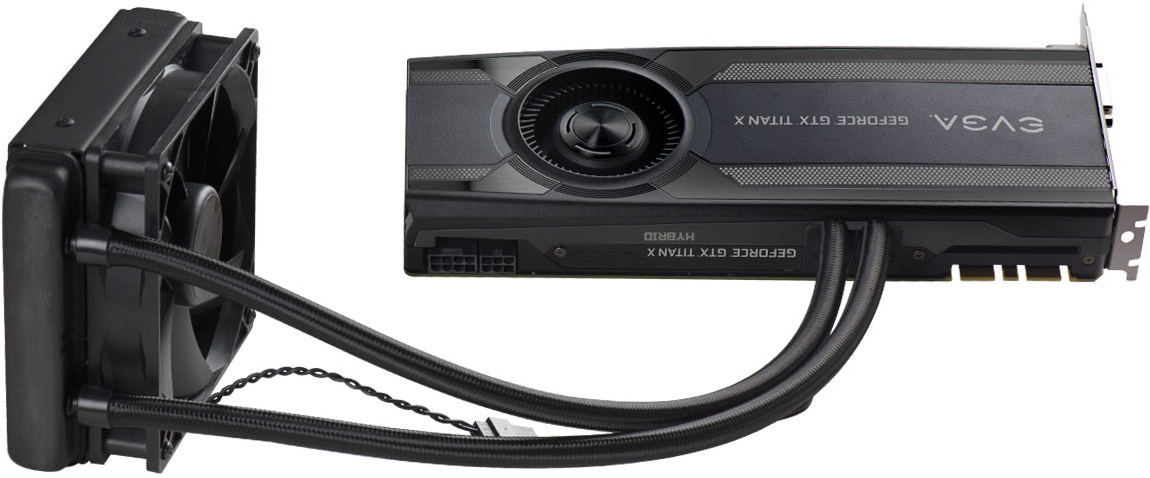EVGA on Friday introduced one of the world’s first mass-produced GeForce GTX Titan X graphics cards with a hybrid liquid cooling system. The new board will hit the market in June and will be one of the world’s highest-performing single-GPU graphics adapters. For those, who already own a GeForce GTX Titan X, EVGA offers to buy its hybrid LCS separately.
At present Nvidia’s GeForce GTX Titan X graphics cards deliver unprecedented levels of performance for single-GPU graphics solutions. While there are numerous factory overclocked Titan X graphics adapters that can demonstrate even higher performance than the regular ones, the vast majority of them use Nvidia’s reference cooling systems. Coolers designed by Nvidia are rather efficient for stock clock-rates, but in overclocked conditions, they become loud and still cannot cool down graphics cards to acceptable temperatures. As a result, many suppliers of add-in-boards install their own cooling solutions on pre-overclocked Nvidia GeForce GTX Tian X graphics adapters.
EVGA was among the first makers of graphics boards to offer a GeForce GTX Titan X with a pre-installed water-block for enthusiasts with DIY [do-it-yourself] liquid cooling solution earlier this year. On Friday, the company became the first maker of graphics cards to introduce a GeForce GTX Titan X with a hybrid closed-loop liquid cooler, which promises to combine maximum cooling efficiency and relatively quiet operation. EVGA’s hybrid liquid cooling solution features a water block with copper base, a large 120mm radiator, perfectly sealed tubes and a fan. The self-contained cooler is likely produced by a contract manufacturer, such as Asetek. According to EVGA, its hybrid cooling solution can cool down Nvidia’s GeForce GTX Titan X graphics processing unit to around 53°C under load, whereas the standard cooler can only cool the GPU down to 85°C under the same load.
The EVGA GeForce GTX Titan X Hybrid graphics card is based on the fully fledged GM200 graphics processing unit with 3072 stream processors and carries 12GB of GDDR5 memory. The GeForce GTX Titan X Hybrid adapter uses printed circuit board designed by Nvidia, but has considerably higher out-of-box GPU clock-rates: 1152MHz/1241MHz base/boost frequencies compared to 1000MHz/1075MHz recommended by Nvidia. In fact, the add-in board has the same clock-rates as the liquid-cooled EVGA GeForce GTX Titan X Hydro Copper. Like other GeForce GTX Titan X graphics cards in the market, EVGA’s factory-overclocked add-in-boards come with 7GHz memory and end-users have to boost frequencies of GDDR5 themselves.
The EVGA GeForce GTX Titan X Hybrid graphics card will hit the market shortly. The company will sell the adapter for $1099. The EVGA all-in-one hybrid liquid cooling system for GeForce GTX Titan X boards is available separately for $109.

Discuss on our Facebook page, HERE.
KitGuru Says: The EVGA GeForce GTX Titan X Hybrid looks like a very solid product with serious performance. If you would like to have something that is more powerful than just a Titan X and for some reason do not want to obtain a Radeon R9 295 X2 or wait for the Radeon Fury, then the new graphics adapter from EVGA may be just what you need.
 KitGuru KitGuru.net – Tech News | Hardware News | Hardware Reviews | IOS | Mobile | Gaming | Graphics Cards
KitGuru KitGuru.net – Tech News | Hardware News | Hardware Reviews | IOS | Mobile | Gaming | Graphics Cards







yay!
♋♪♪♪♪♋$ $83 /hour @mi5//
➨➨➨http://DigltalWorkCloud.com/C0mputing/0ssub…
♋♪♪♪♪♋$ $83 /hour @mi5//
➨➨➨http://DigltalWorkCloud.com/C0mputing/0ssub…
Would love to see head to head Fury X v water-cooled Titan X (or water-cooled 980ti if one is out yet) and then a Fury v gtx980ti comparison…. That way we can see genuinely whether the Fury range is faster like for like, or just because of the ability to overclock due to cooling.
The radiator is far too thin.